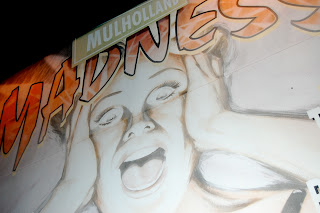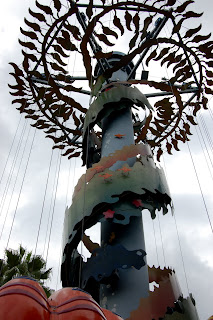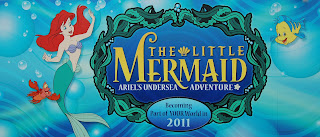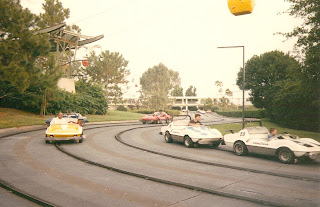We finish our tour of Paradise Pier and Disney California Adventure with a look at a recently-extinct attraction, Mulholland Madness. Named for and inspired by Mulholland Drive, the scenic 50-mile stretch of road from North Hollywood to the Malibu Coast, this "wild mouse"-style coaster offered guests a twisting, turning ride much like portions of its famous namesake.
The face of the attraction was adorned with a gigantic, unfolded road map of Mulholland Drive. Depicted on the map was everything from Marilyn Monroe to a landslide on the Pacific Coast Highway. Of course, while traffic was jammed on the PCH and the Hollywood Freeway, everyone was freewheeling along Mulholland... so much so, that the cars of the ride even appeared to crash right through the map at one point! The map also included a nod to Alamo Rent A Car (operating sponsor of the attraction from 2004-2010) and an image of a swimming pool shaped like Mickey Mouse.
Each of the coaster cars on Mulholland Madness featured four bucket seats and its own custom paint job. There were hot rods and Woodies and even squad cars of the California Highway Patrol.
Cars and car culture were the principle design motifs on Mulholland Madness. Everything here contributed to the story, from the orange net fencing around the perimeter to the "Cast Members Only" sign made to resemble a license plate. Even the height stick looked as if it belonged on the side of a highway.
The use of road signs in the queue and load areas continued along the ride path as well, with the addition of billboards advertising things like Mulholland Drive-Thru Donuts and Mulholland Madness the movie, starring Teri Fide and Rolly Coasta.
Mulholland Madness closed in October 2010, to be re-imagined as Goofy's Sky School. The new attraction is set to debut this summer.
The district of Paradise Pier which included Mulholland Madness, stretching from Burger Invasion to Dinosaur Jack's Sunglass Shack and roadside merchandise stand Souvenir 66, was intended as an homage to California's infatuation with the automobile. While these opening day features may have driven into history, the park is actually preparing to hit the gas on an even bigger tribute to cars, chrome and the "Mother Road" with the 2012 debut of Cars Land.
Guests visiting Disney California Adventure now can get a sneak peek at the new land under construction. The wall in front of the project has been dressed as oversized postcards, touting some of the new attractions and destinations opening next year. Among my favorite details on the wall: perforations between the cards and the price tag!




















































